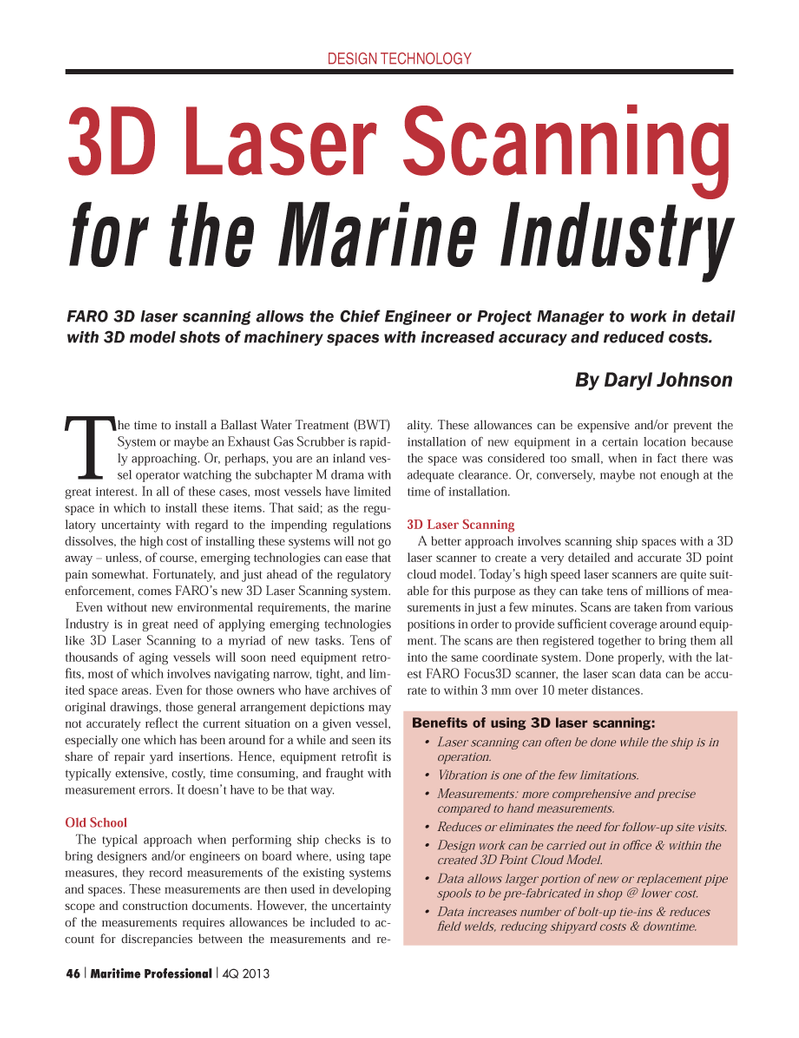
Page 46: of Maritime Logistics Professional Magazine (Q4 2013)
Shipbuilding, Repair
Read this page in Pdf, Flash or Html5 edition of Q4 2013 Maritime Logistics Professional Magazine
The time to install a Ballast Water Treatment (BWT) System or maybe an Exhaust Gas Scrubber is rapid-ly approaching. Or, perhaps, you are an inland ves- sel operator watching the subchapter M drama with great interest. In all of these cases, most vessels have limited space in which to install these items. That said; as the regu- latory uncertainty with regard to the impending regulations dissolves, the high cost of installing these systems will not go away ? unless, of course, emerging technologies can ease that pain somewhat. Fortunately, and just ahead of the regulatory enforcement, comes FARO?s new 3D Laser Scanning system. Even without new environmental requirements, the marine Industry is in great need of applying emerging technologies like 3D Laser Scanning to a myriad of new tasks. Tens of thousands of aging vessels will soon need equipment retro- ts, most of which involves navigating narrow, tight, and lim- ited space areas. Even for those owners who have archives of original drawings, those general arrangement depictions may not accurately re ect the current situation on a given vessel, especially one which has been around for a while and seen its share of repair yard insertions. Hence, equipment retro t is typically extensive, costly, time consuming, and fraught with measurement errors. It doesn?t have to be that way. Old SchoolThe typical approach when performing ship checks is to bring designers and/or engineers on board where, using tape measures, they record measurements of the e xisting systems and spaces. These measurements are then used in developing scope and construction documents. However, the uncertainty of the measurements requires allowances be included to ac- count for discrepancies between the measurements and re-ality. These allowances can be expensive and/or prevent the installation of new equipment in a certain location because the space was considered too small, when in fact there was adequate clearance. Or, conversely, maybe not enough at the time of installation.3D Laser ScanningA better approach involves scanning ship spaces with a 3D laser scanner to create a very detailed and accurate 3D point cloud model. Today?s high speed laser scanners are quite suit- able for this purpose as they can take tens of millions of mea- surements in just a few minutes. Scans are taken from various positions in order to provide suf cient coverage around equip- ment. The scans are then registered together to bring them all into the same coordinate system. Done properly, with the lat- est FARO Focus3D scanner, the laser scan data can be accu- rate to within 3 mm over 10 meter distances. BeneÞ ts of using 3D laser scanning: Laser scanning can often be done while the ship is in operation. Vibration is one of the few limitations. Measurements: more comprehensive and precise compared to hand measurements. Reduces or eliminates the need for follow-up site visits. Design work can be carried out in of ce & within the created 3D Point Cloud Model. Data allows larger portion of new or replacement pipe spools to be pre-fabricated in shop @ lower cost. Data increases number of bolt-up tie-ins & reduces eld welds, reducing shipyard costs & downtime. DESIGN TECHNOLOGY3D Laser Scanning for the Marine Industry FARO 3D laser scanning allows the Chief Engineer or Project Manager to work in detail with 3D model shots of machinery spaces with increased accuracy and reduced costs. By Daryl Johnson 46 I Maritime Professional I 4Q 2013MP #4 34-49.indd 46MP #4 34-49.indd 4612/11/2013 1:32:46 PM12/11/2013 1:32:46 PM

 45
45

 47
47
